THE CENTER FOR SOCIAL IMPACT

(N.) A STATE THAT IS BETTER TODAY THAN YESTERDAY
REGENERATIVE SOCIAL IMPACT A COLLECTION

UVU CENTER FOR SOCIAL IMPACT VOL. 3 2023
2 Contents Cassie Bingham, Assistant Director - Center for Social Impact 4 Introduction 6 provecho Alex M. Ruiz Gaspar, Direct Service Impact Fellow 8 on intimacy Brodie Mitchell, Systems & Design Impact Fellow 10 story saves the world Hannah M. Filizola Ruiz, Community-Engaged Learning & Research Impact Fellow Hannah Rowntree, Outreach Impact Fellow 12 regenerative healing is social impact 14 floral reprieve Kate J. E. Hickman, Systems & Design Impact Fellow 16 13 pillars Kiona Wilson, Policy & Governance Impact Fellow 18 renewal María Claudia Linares Rigacci, Communications Impact Fellow
20 how i get in touch
Oscar Terriquez-Hernandez, Community Organizing & Activism Impact Fellow
22 grounding: a personal narrative
Savannah Clyde, Philanthropy Impact Fellow
24 the fourth sign of the zodiac
Valentina Ramirez, Social Entrepreneurship & Corporate Social Responsibility Impact Fellow
26 healing is with
Cassie Bingham, Assistant Director - Center for Social Impact
28 the gold is abundant
Jo Mower, Program Director - Pathways
30 flowers
Kaile Akina, Program Director - Outreach credits
Estrella Chinchay, Publication Designer & Editor
Sieglinde Hugo, Editor
&
3
Contents
Credits
It feels like a natural progression for the third volume of Protopia to be about regenerative social impact. Each year, our student Impact Fellows choose a theme to guide their submissions. The first cohort focused on the work of decolonizing, due to how far removed Western social impact strategy often falls from the communal, reciprocal practices of Indigenous traditions. In Protopia’s second year, students chose to explore the flawed human nature behind motivations to make change, and how to engage that humanity with compassion and grace. For this third volume, our Impact Fellows built upon the past explorations of repairing harm while leaving space for error with a nod to the healing powers of engaging humbly and sincerely with changemaking. They wanted to send the message that although making social impact requires contact with the grief, frustration, and rage that naturally accompanies exposure to harm and suffering, it also produces regeneration.
There are multiple definitions of “regenerate,” but one especially compelling for this context is “to bring new and more vigorous life.” We live in a world where so many human-to-human relationships and human-to-animal/land/water/air relationships are inherently treated as transactional at best and exploitative at worst. The urge to challenge such practice by considering community behavior that leads to revival and new life is thrilling. We believe it is possible to dismantle oppressive systems and redesign them as care infrastructures as we reorient how we view relationships to humans and beyond. When social impact practice is based on the trust and connection required to foster safe relationships and belonging, it leads to this possibility, and ultimately provides us with personal and collective regeneration.
As you explore the following collection from this year’s Impact Fellows and advisors, we ask you to consider the following inquiry: How might social impact practice be a source of regeneration for me? There are many answers to this question - but we think it starts with community. As Reverend Jennifer Bailey said, “Relationships move at the speed of trust, and social change moves at the speed of relationships.” We hope whatever form your social impact takes, it will seek to mitigate harm caused by paternalism, colonial frameworks, supremacy doctrines, and exploitation, and further embrace healing through relational strategy, communal care, equity-centered design, reciprocity, and renewal.
Cassie Bingham, Assistant Director Center for Social Impact
4 introduction
2022-23 Social Impact Fellows
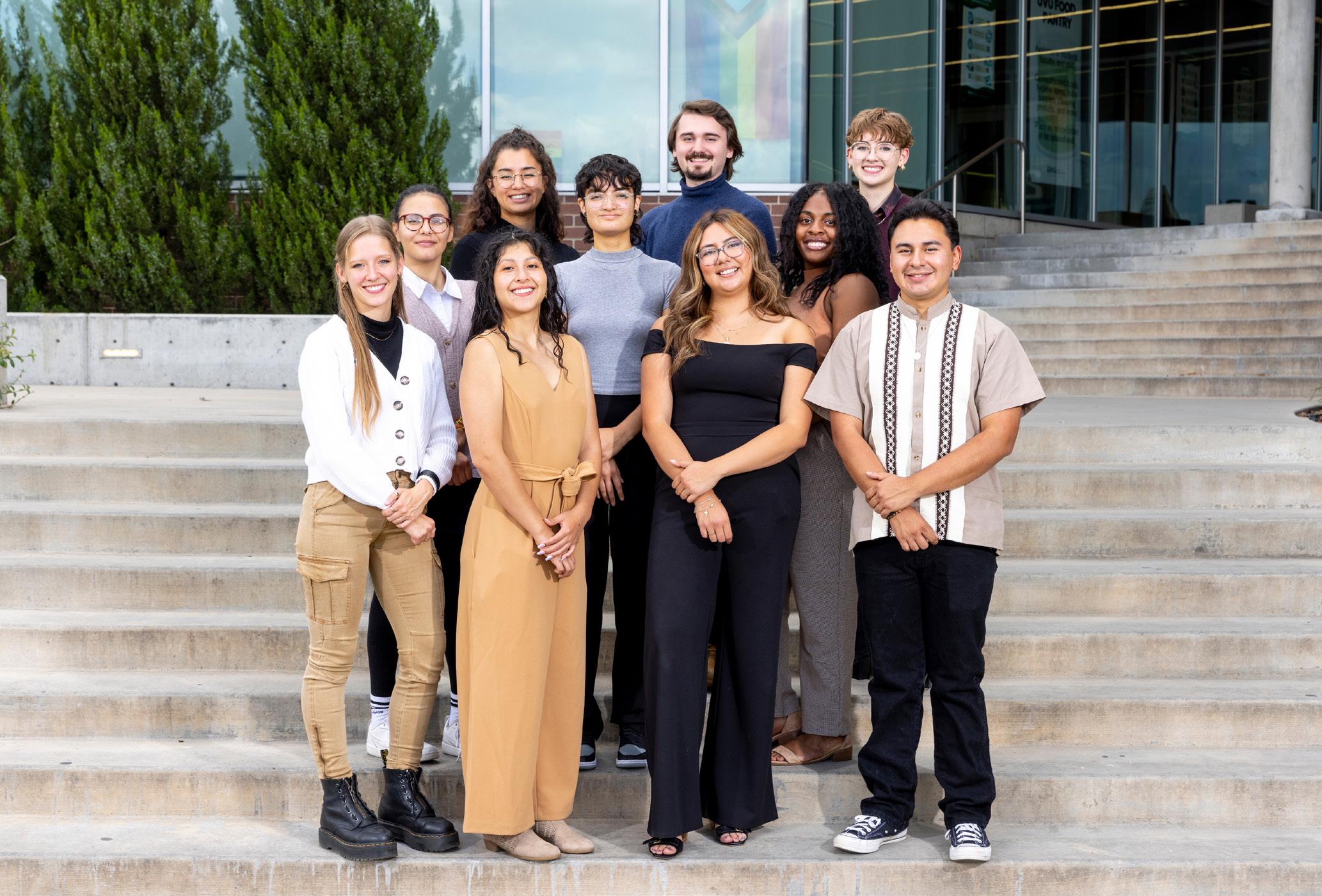
Introduction 5
Top row, from left to right: Kiona Wilson, Brodie Mitchell, Savannah Clyde
Middle row, from left to right: Valentina Ramirez, Hannah Filizola Ruiz, Hannah Rowntree
Bottom row, from left to right: Kate Hickman, María Linares, Alexandra Ruiz, Oscar Terriquez
Provecho
Jaime Sabines, Horal / La Señal
6
“Alguien me habló todos los días de mi vida al oído, despacio, lentamente. Me dijo: ¡vive, vive, vive! Era la muerte.”
La comida sana. De pequeña era en la cocina donde siempre estaba la música y mi familia platicando. Desde mi abuelita y abuelito, hasta mis tías y tíos. Todos sabían cocinar y todos tenían su especialidad. Cuando me sentía enferma mi abuelita siempre sabía de un té que me iba a ayudar a sentirme mejor. Cuando me sentía triste mi familia me hacia mi comida favorita. Cuando había algo para celebrar, hacíamos comida. Aun sin saber mis malestares, la comida siempre me sanaba. Yo siempre quería estar en la cocina, me sentaba en la barra, escuchaba a mi familia platicando, y esperaba a que me dejaran ayudar. Siempre me contaban de como nuestra familia en México, o familiares que ya no están con nosotros, hacían la comida. A la hora de comer, era como si el tiempo parara. En ese momento sentíamos el amor y la presencia de todos nuestros ancestros que en un momento en el tiempo también estaban sentados compartiendo el mismo platillo que nosotros. En ese momento estamos todos juntos.
El impacto de la comida es grande. Une a personas y les da la oportunidad de compartir un momento íntimo y único porque nunca sabes cómo va a saber a la próxima-- nos recuerda que frágil es la vida. ¡Tienes que vivir! Cocina con tus seres queridos, invítalos a la mesa, coman juntos. Porque con el tiempo el platillo se queda, pero nosotros no. ¡Provecho!

7 Alexandra M. Ruiz Gaspar
on intimacy
For me, social impact practice is about intimacy, and I find regeneration through intimacy.
Intimacy has not been easy for me. Intimacy has often and still does, scare me. The scary thing about intimacy, as I’ve experienced it, is its persistence. When I say that intimacy is persistent, I mean that it is attentive. Being attentive to someone, or to myself, is scary because in its persistence it erodes the safety of personality. Being attentive, which is intimacy in action, means seeing the person in front of you and making them your focus. Why would this be scary? Having someone pay attention to me sounds nice. The scary thing is that my own sense of self-worth becomes infinitely more precarious when reflected back to me from someone who cares about me. Personality is fixed in my mind. Personality is a collection of qualities that give shape to what I do every day, why I do it, where my pitfalls are, and what my trajectory is. Personality is like a map. There’s something fixed, almost immortal about it. When someone who cares about me sees me and I recognize that, it’s like looking up from the map and seeing the actual terrain. The person they see is not personality. Instead, they see the weathered and constantly shifting terrain of a person.
How does this relate to social impact? Social impact, which relies on systems thinking as a methodology, aims as understanding terrain. By focusing on terrain, it makes people its concern rather than personalities. A simple distinction can be drawn up that is present in our university system. If someone wanted to change our world to make better
personalities, they would focus on the maps we draw up of ourselves. How can we change how students think of themselves? What’s wrong with the maps students are using to get from day one to graduation? A systems analysis, or social impact strategist, would instead ask, What terrain does the student find themselves in? How much do they pay for rent? Where do they buy food from? What do they eat? What is the quality of the water they are drinking? How much sleep do they get? How much work is required of them each day? When and where do they socialize and who do they socialize with? The underlying question is now completely different. Maps, like personalities, dominate terrain. One’s person, body and mind, becomes things in service of producing personality. A map helps zone and determine how to use land, like a personality helps zone one’s body and time to determine how one will use oneself, as if we are built to be extracted from. Intimacy throws personality away because it is harmful. I didn’t do well in this class. Oh? Have you had food today? Water? Let’s take a walk. I’ll listen. Put the map down, we need to focus on the terrain. This is what intimacy sounds like.
James Baldwin, in his essay “Down at the Cross”, spends about a page and a half unpacking the concept of sensuality. I think that Baldwin’s notes on sensuality share a kinship to what I’m describing as intimacy. Both sensuality and intimacy are about putting attention on the person in front of us, their whole self, their terrain. The quote on the right, pulled from Baldwin’s essay, communicates my point more effectively.
8
9
Brodie Mitchell
“To be sensual, I think, is to respect and rejoice in the force of life, of life itself, and to be present in all that one does, from the effort of loving to the breaking of bread”
James Baldwin, “Down at the Cross”
Story saves the world
Regeneration to me comes through story. Understanding social change only as protests and rallies and lobbying transforms the work into an endless labor. Social impact is more than a sterile project or a sequence of events, and understanding it in that way ignores the relationships embedded in the work. Storytelling is what brings life and people and relationships into how we understand social impact. This world is volatile and unpredictable. People wake up to existence, coming to consciousness at different ages and in different contexts. We wake up and look to one another to understand how the world became as it is. There’s something deeply isolating about waking up to a world that hasn’t nurtured you, hasn’t claimed you. Our humanness craves story and stories represent our first attempts to locate ourselves in that volatile world. They’re how we come to understand ourselves and why we’re here and what we ought to do.
For the individual, participating in story, by hearing or telling, is an attempt at human portraiture, documenting the patterns and tendencies of human thought. Story is a way for people to shave off pieces of themselves, immortalizing their experiences, history, and perspective, enabling the common individual to contribute to the intellectual history of humanity, offering their own perspective up as a piece of the puzzle that is life and existence. All story is the authors’ donation to the lifeblood of humanity. It is how we reach out, extending ourselves both to others and even to ourselves, through ourselves and toward ourselves.
More than this though, stories are communal. As a cartographer marks their steps by sketching out a map, so too does a community track their existence by telling a story. Story is how we share ourselves with one another. For a community or a culture, story is about sense-making, forming the foundation for how groups see the whole of the world. A story is a shared personhood. An interdividuality. It is what unites humanity, forming a network of shared interpretation; a social space where dialogue and communal growth can occur.
Understanding it like this, this work is necessarily a communal act. Our willingness to work together towards something we’re not certain can ever truly be achieved is our participation in a common substance. It’s how we preserve our humanity and nurture it.
Oppression happens when these stories we tell ourselves fragment, and suddenly somebody’s perspective begins to dominate and eventually drown out everyone else’s. What we do when we work towards a common future is reweave those broken
10
fragments back into a common story that cares for and represents us all. Stories engender compassion and compassion saves the world. Creating a new, communal, compassionate story is a work that is necessarily recuperative, and regenerative. It is a re-creation of the world.
From this perspective, storytelling and storyreceiving, then, become essential manifestations of that fundamentally human quality of persistence in the face of impossibility. Telling to be understood and listening to understand testifies of the fundamentally human quality that unites all organizing: the drive and hope that pushes us to find each other and seek a common future even in the absurd, heartbreaking face of our fractured present.
Working at the Center has helped me come to understand my role in this, our collective mission: to gather stories. Story is the soul behind the mechanical movement of showing up. It’s what makes our participation in the work meaningful and continuous. It’s what’s going to keep the work moving when it feels like there’s nothing left. Storytelling is a fundamentally creative act in the face of a destructive reality. It’s how we reach for one another, and absurdly, impossibly find someone else reaching back. It is, fundamentally, an act of faith and hope.
We won’t forget ourselves.
Working on the podcast was my unique opportunity to try my hand at gathering stories. It was one of the most meaningful projects I’ve worked on in my whole life.
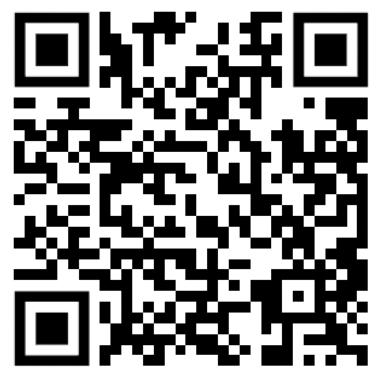
11
Hannah M. Filizola Ruiz
Regenerative Healing is Social Impact
Love, despair, fear, joy sacred witnessing of Us one body, tethered
12
Making space for my sacred rage has healed me. My community rejuvenates & ignites my passion through love and sacred witnessing of me. My community sees me. They hear, and love, and cherish me. I can show up as I am.
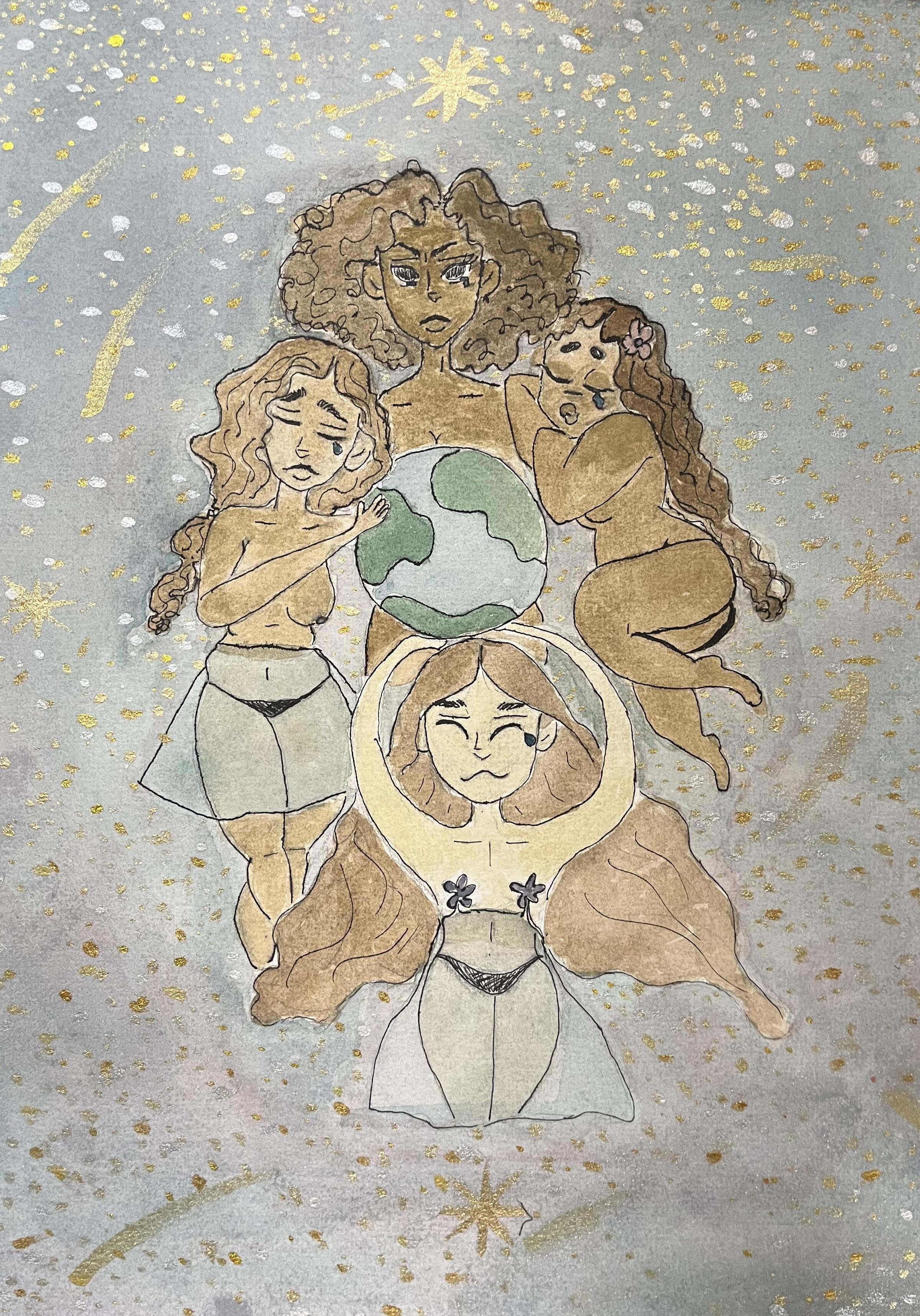
Hannah Rowntree 13
floral reprieve

14

15
Kate J. E. Hickman
20 March 2023
On a beach beneath the cliffs of some small, obscure township, a curly-haired overalled person will fill half a dozen feed buckets with Irish Sea water in a futile attempt to make salt. She will dip the ultimate bucket into the water and struggle to pull it from the tide. Many ambitious projects are foolish enough to warrant no one’s sympathy, but she is not looking for sympathy. The passing of time sometimes leaves a space where nothing really exists—a space where the absence of all things is felt and the presence of them, too. Thus, one must remain in motion in order to survive the unfolding chaos that saturates all.
The curly-haired American person will load that last bucket into the back of a rusty pickup truck or maybe a used station wagon. She will close the tailgate or the trunk and will turn back towards a sun hanging an hour-margin above inky waters. There is an illusion of stillness in the sun, but it will surely sink below the shifting currents again. Maybe the sight of it will overwhelm our dear humble character, and she will take a picture of it on her phone before setting off toward home which we can almost most surely assume will be a dusty renovation project in the middle of nowhere. It will be an hour from the seaside.
Close to home, the stars will sear a darkening sky, and our dear humble narrator will look up at them in what might be an unusually clear sky. Something about it will trigger the memory of sitting on the floor of an apartment in downtown Salt Lake City, but the connection between the twinkling stars and that place with those people will not come to mind. Maybe in a night to come, when the stars appear again, I will imagine the smallest astronaut roaming the (strangely) neatly raked red sands of Mars.
I will carry into this new home the containers of salt water, and it will feel quicker than the seaside retrieval and far more tiring. I will labor to occupy my mind in the empty space between here and there, especially in the event that someone comes to visit. I will vibrate with the anticipation of meeting someone I know again for the first time, and it is when I open the door after hearing a knock that I will remember I am miles away from home.
I confess this is an attempt to explain to you the tension I feel in social impact work. This projection into a future that does not exist, but could shakes my soul because how can I tell you what it feels like to have been loved, to be loved, by so many with a depth that I can only describe as healing. The weight of it
16
13 pillars
alone will crush me a thousand times, but it turns on itself and is converted. Cherished memories held in one hand and the inevitable decay of a life previously known thrusts me forward like a beam of light across a dark universe.
When I open the door for you, my dear friends, in whatever place I live, there will be remnants of all time as it accumulates for me. I will make my own countertop fermented elderberry soda, because I miss Utah, but I will also tell you about my neighbors and the community I belong to. I will show you the houseplants I brought over and the garden I started, and your photos will appear alongside new ones on the walls of my home, photo albums, and digital timelines. I hope to sit in thirteen highbacked wood chairs around a wooden table that I thrifted or my dad lovingly (and begrudgingly) made for me. Like pillars, we’ll sit and eat and catch up, and I will feel so full that I internally burst.
I will chase that high forever, and I will find as many people as I can to have around my proverbial dinner table. In the chaos that will be my future house renovation, irresolvable mistakes in my personal life, failure and bust in my professional advocacy work, and not feeling strong enough to advocate for those I love, I will find the “simple alignment” among the pillars.
We were leaning over the world’s edge, and we did not fall.
Eventually, the night will end, and you, my fellows, will go back home, too. Going back to the seaside, seeing the stars, seasoning with salt, something will remind me of you, again, but the story that was there will be lost. So I will write a new one, and I will call it “love”. I leave you with this story of regeneration.
Love, Kiona
Kiona Wilson 17
Renewal

18
I celebrate the creation of change and bathe in the experiences found within the sacred walls built on these grounds a place where social impact was uncaged celebratory moments were exchanged but weary lies my soul – I’m left worn down these chaining systems that I’ve seen around have entertained a fight and left us strained an edging war for restitution and to end my people’s persecution although the battle is long and endless the weight of the change we stress is lifted where habits show my thoughts on rest shifted leaving my spirit recharged and boundless
19
María Claudia Linares Rigacci
how i get in touch
I haven’t always thought of how the earth is in danger. I wasn’t aware of the ways I was participating in the ever-growing pollution of our own planet that does so much. And I own the harm I have done. I am aware of the different ways I have impacted pollution. Owning what you have done is the most essential and also difficult thing to do to start regenerating. Regenerating isn’t something you learn in a class and come out knowing everything, it’s a learning process, you’ll have failures and successes, trial and error.
During my time here at the center I had “Becoming kin: An indigenous call to Unforgetting the Past and Reimagining our future. Krawec, P., & Estes, N. (2022)”, recommended by Hannah Filizola-Ruiz, our cohorts Community Engaged and Research Fellow. In the book, it uses the word Nii’kinaaganaa and gave the meaning, “Nii “I am” or “my” Kinaa: “all of them” Ganaa: “relatives, my relatives” The phrase could mean any of these things: I am my relatives, all of them. I am related to everything. All my relations… From our earliest creation stories, the Anishinaabeg (plural of Anishinaabe) understood themselves to be related not only to each other but to all of creation.” Krawec, Patty. (2022, p.1). We are related to the Earth.
Mother nature provides us with everything we need, that be basic needs like food, water, shelter, and also things we will need like herbs to use as medicine, love from other animals, and the patterns the earth has to make us curious and learn
how to nurture it. With that nurturing of the earth brings us peace, peace that we need during stressful times. We go walk/ hike, take care of our loved animals, care for our plants that provide us clean air, and fruiting plants that give us nutrients for helping them bloom.
The way I rejuvenate from the taxing time and energy I put into social change is enjoying what the earth has provided us. That be physically, mentally, and spiritually. I have recently started gardening, finding joy in starting my small garden from seeds and then working my bit of earth to be balanced to grow my fruits and vegetables to share with family and friends through making food or giving the fruits to them. One way I connect with the Earth mentally is reading and learning what things the Earth provides us to maintain homeostasis. I like to see this as a way to connect with my indigenous ancestry and how they would deal with mental health. It brings me into connection with the Earth and the mind. For example, Yolloxochitl was used by the Mesoamericans for people who had the “scared disease” (anxiety/schizophrenia) and other illness. Mental stupor was equally believed to be due to an excess of phlegm in the chest and could be treated with herbs to induce vomiting. Yolloxochitl, one particular herbal medicine applied locally to the head, helps the frenetic and crazy, removes fear (anxiety/ schizophrenia), returns to consciousness those who have lost consciousness for any reason. These symptoms would not be viewed as physical conditions, but rather psychological or spiritual. Hearts being eaten (by bad spirits), squeezed, congested, and crushed, causes symptoms like spinning around, being skidish, and wanting to die.
20
Yolloxochitl: Which translates to heart-shaped Flower; Mexicana Magnolia is a southern magnolia tree that is native to parts of Mexico, Honduras, and Guatemala.




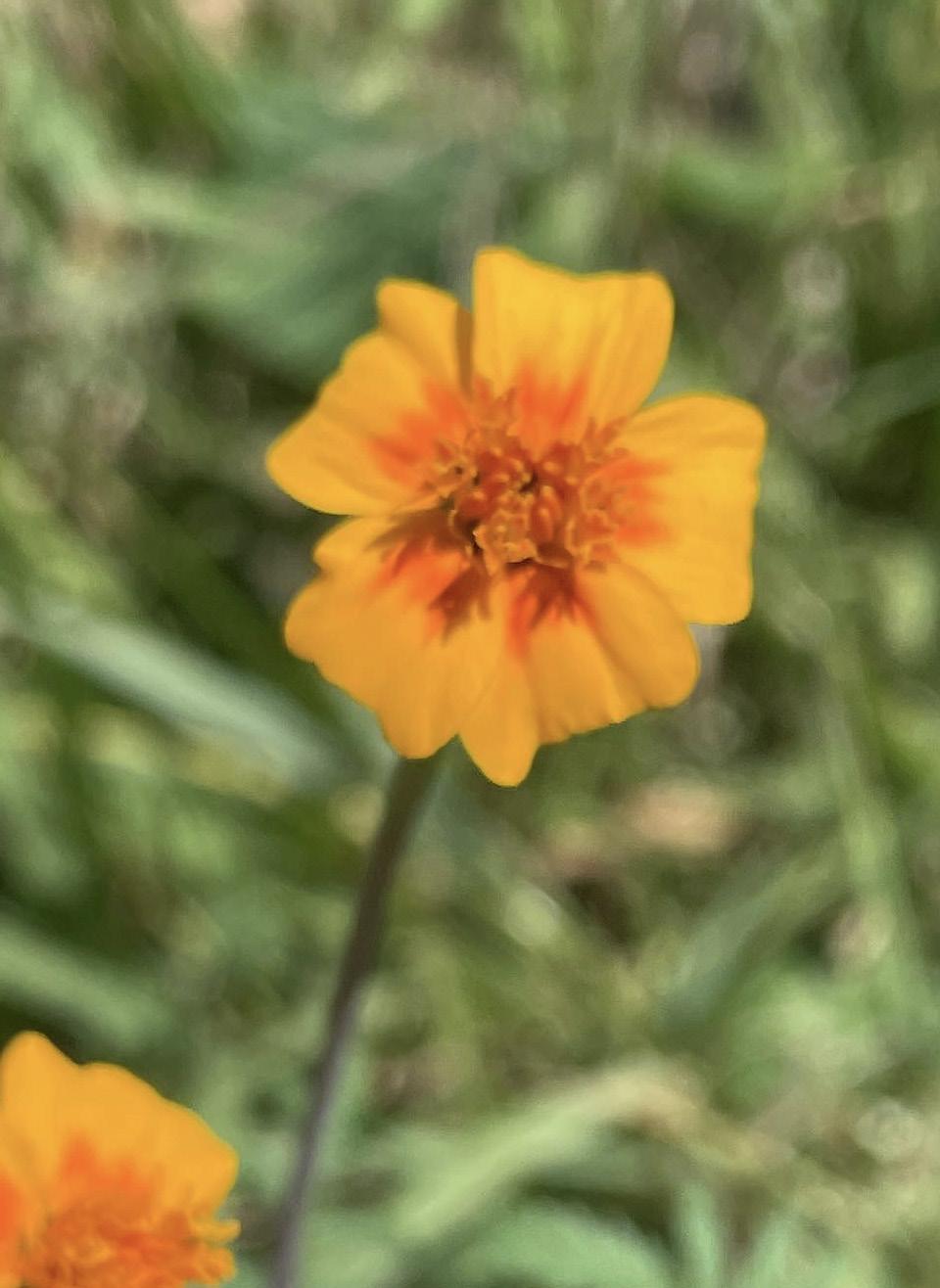 Oscar Terriquez- Hernandez
Oscar Terriquez- Hernandez
21
Grounding: A Personal Narrative
At 5:00 am I had resolved that if sleep was going to evade me, I would rather go walking than stare at the ceiling. It was that part of summer mornings where the sun was still contemplating rising, but it peeked out enough that you could still see. I was living on the edge of Springville UT, where the surrounding fields and train tracks met the residential suburbs. I walked past the last residential house and on to the roads after the sidewalk ended. Admittedly unsafe, paralleling the tracks, the road was a narrow strip of asphalt where the speed limit was treated as a suggestion, and cars barreled down it on their way to the closest freeway entrance. However, that same freeway entrance had a gas station, and with my lack of sleep as the inspiration I named that Maverik as my destination with a red bull as the reward.

Walking has always brought an abundance of introspection and I realized that even though I had driven on this road hundreds of times I had never walked it. It was an easy answer as to why. I counted the busted bottles of alcohol, needles, discarded furniture, 32 oz styrofoam cups, and a plethora of other trash that had likely been discarded out driver-side windows. The sky was expansive though, if you could shift your focus away from navigating through the debris, and gravel to look up; it was almost jarring. A strange comfort to feel small and insignificant, on a planet hurtling through space; somehow cursed with consciousness so you can be aware of it all; peak karmic comedy. However, the weeds were gorgeous. Masses of spiny purple thistles, flushes of dusty pink milkweed, and bunches of
other small flowers. It was an obscure reverence as a slow observer on a road that is nothing more than a blur to those who travel it. I imagine that the drivers of each car that passed me thought I was stupid for walking on this road, crazy for being up so early, or maybe they paid me no mind. After all, I am also guilty of mentally criticizing the actions of those I momentarily observe from the safety of my vehicle, before I drive on. I made it to the Maverik, got my red bull
and a yogurt, but before heading back I decided to venture to the overpass that ran above the freeway. I walked across to where I was standing above the barrier between northbound and southbound traffic and I sat down to eat what I guess was breakfast for the day.
I hadn’t been able to sleep because to put it simply: I felt fucking crazy. The world was falling apart and I couldn’t understand why so few people around me seemed to care. It had only been a month since the draft of the opinion that the Supreme court was planning to overturn Roe v. Wade, and Dobbs v. Jackson had been leaked. I was struggling to cope with the implications of what that could mean for the right to bodily autonomy, and privacy, as well as the fear that this was only the beginning, because if the court precedents could be so easily rewritten

22
then the reality of what the future could hold was all the more daunting. In doing something out of my routine, devoid of convenience or practicality, immersing myself walking in place of what was usually tire tread was a desperately needed morning of catharsis. As I sat on that overpass watching cars race under me, eating a poor excuse for breakfast my phone buzzed with a news notification. Today was June 24th, 2022.
On June 24th, 2022 the Supreme court of the United States abandoned nearly 50 years of court precedent when they overturned Roe v. Wade. But to those immediately around me, it was just a Friday.
My family had already secured their place in the comforts and privileges of white suburbia with just enough proximity to wealth to keep them in the time loop of forever pursuing capital while simultaneously robbing them of the capacity to care about much more than outward appearances and their retirement fund. I had already tried to convey the seriousness of what was happening in our country, but once you are crowned with the jesters hat of heresy your words are seldom regarded with any air of gravity. Exhausted, helpless and angry, I wondered how much longer I could fight the apathy off.
A few days later, I walked into a room for my first training as a fellow for the Center for Social Impact at UVU, where I found myself in company with strangers who would quickly become some of the most brilliant, courageous, and radically empathetic individuals I have ever had the pleasure and privilege of knowing. I sat in that first meeting with them as we introduced ourselves and to my surprise, Roe v. Wade was acknowledged. I watched in awe as space was held for the burnout, the anger, the sadness, and the overwhelm that the Supreme Court decision had caused, and like it was second nature solidarity was
held. That meeting was like finally hearing thunder when I had been stuck in a desert, like a promise that rain would come. After that meeting I sat in my car and sobbed in relief. I was not alone.
I don’t know if we will ever be able to fully dismantle the harmful systems of capitalism that are maintained by oppression and exploitation. I don’t know how much worse it will have to get before it gets better. I didn’t know if you could come back from burnout. I found social impact because it is a work that is full of people who are not only brave enough to acknowledge social injustice but are radically dedicated to cultivating change that is sustainable and transformative.
My Friends and Mentors: Cass, Kai, Jo, Alex, Brodie, Hannah Rowntree, Hannah Filizola Ruiz, Kate, Kiona, Mari, Oscar, and Vale, I feel regenerated through social impact practice by being in community with all of you. Yes, life often feels like trekking along a trashed, dangerous, poorly planned road, but there are also flowers. I have found that hope for change is not so elusive when you find people who share in the vision
that life can be so much more than surviving, and that every single person is deserving. Thank you for your compassionate relationality, I love you all.

23 Savannah Clyde
The fourth sign of the zodiac
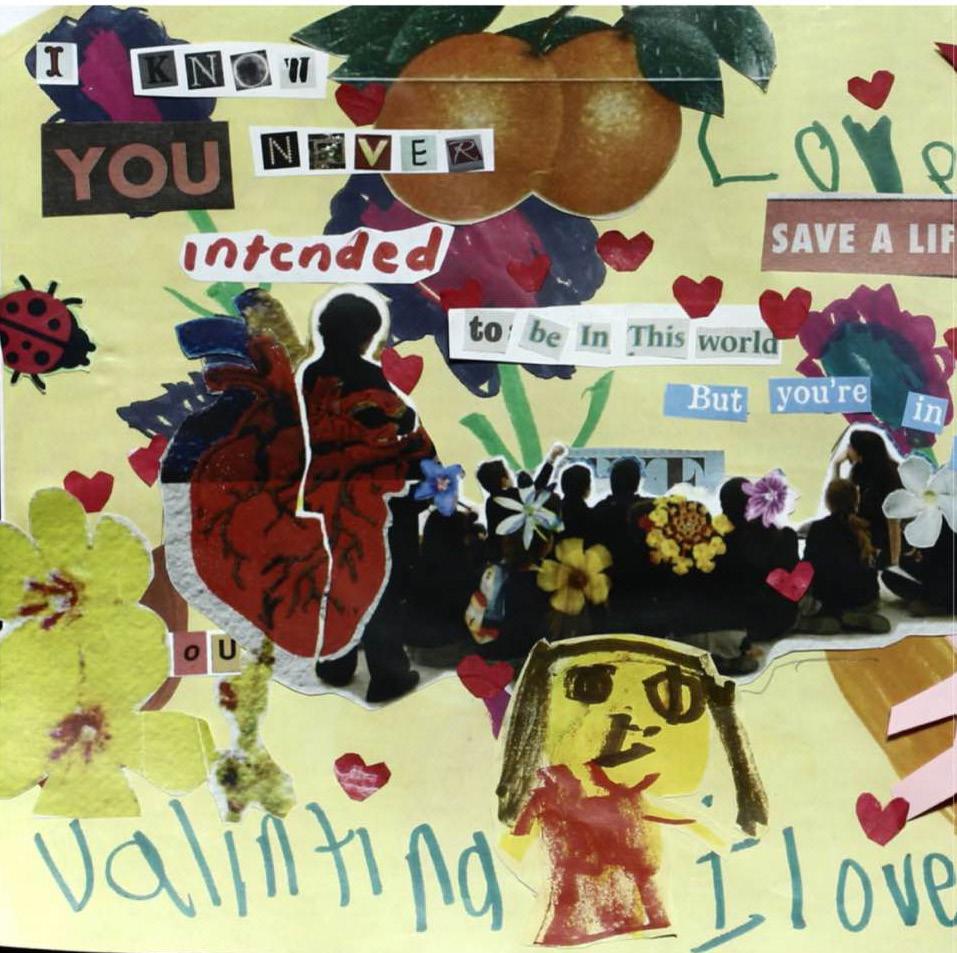
24
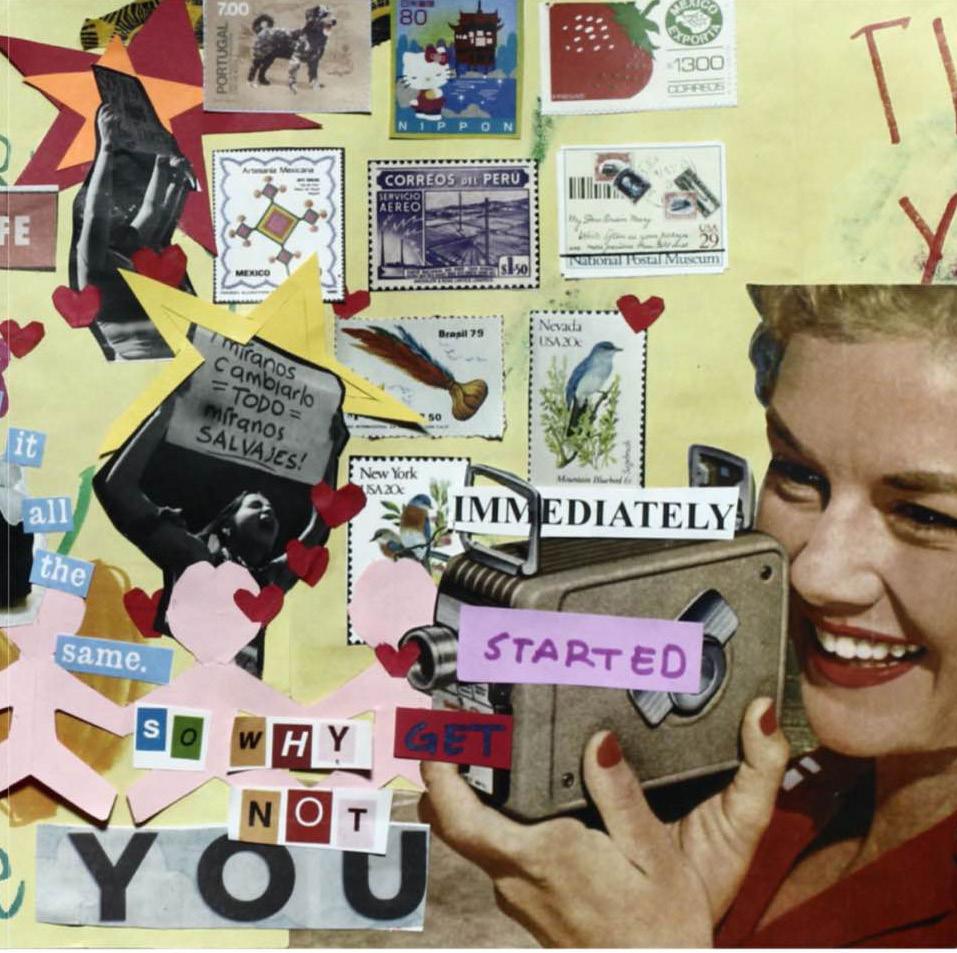
Valentina Ramirez 25
healing is with

26
As an American, I’ve often been taught that individualism to the point of isolation is a virtue worth pursuing. This was further framed by my religious upbringing that embraced capitalistic interpretations of “self-reliance,” including bootstrap ideology, purity culture, and prosperity doctrine. Happiness and fulfillment were frequently claimed to require insular interactions in a small group of people who lived “righteously” and nuclear family arrangement that excluded anything outside of heteronormative structure.
I’ve come to learn, instead, that fulfillment and rich, happy moments come through expansive, safe communities of belonging. Safe community and belonging require inclusion and acceptance, and don’t create conditional worthiness based on patriarchal, hierarchical imperatives. Safe community fosters belonging that flows beyond the social structures of family units and race relations and sexual orientations and gender expressions that fall within the status quo. Regenerative social impact is produced by communities that facilitate regeneration. My ethos has become community learning, community care, and community transformation that leads to new imagination and ultimately new systems.
27
Cassie Bingham
The gold is abundant
This is the first desk job I have had. Being a High School and adjunct teacher, I have always shared my space with my students. Decorating my first office space is new territory for me. I thought this vase from IKEA was pretty cute. I brought it in and put it on the shelf. That’s what you do right?
Then, one day, when I was minding my own business, came the sound of ceramic rolling up against that fake wood. The sound stopped and there was a moment of silence before the crash. The noise of the crash attracted the attention of the fellows. I too looked down at my not-so-significant IKEA vase, now in many pieces on the ground. Savannah came right over and began collecting these pieces in a bag. I had already given up on it. I was sad, not for losing a vase, but because my first attempts to decorate an office were crashing to the ground. But Savannah wanted to revive it. They took it and mended it together with gold. You will have to ask them how, because it’s a skill I do not have.
When they brought it back many months later, to be frank, I had forgotten about it, and the act of kindness brought me to tears. As Savannah gave it to me and we admired their work, Kate pointed out where the vase must have landed, where the point of contact is. Fascinating to see the system of cracks and how they were influenced by one point of force. This vase now was stuck in the back corner of my mind for some time. The gold-lined vase now sits very close to me. Right next to my computer. I like to look at it. Not sure why exactly. Then the assignment to submit something for this zine came along, and this vase came dancing from the corner of my mind to the forefront.
Not only does this vase hold the act of kindness Savannah gave me, or the clever detail Kate paid attention to, but it holds the meaning of community care and love. Many times the work we do here highlights the pain of the world. The systemic cracks that seem to keep cracking. When I turn my head to the right, away from my computer screen, away from this pain, I see this vase. It reminds me to turn my head to the left as well, where I will see the fellow’s space, who tends to be buzzing about this or that. Whether they are laughing about what cartoon characters to smash or pass, or crying over heavy news of grief or pain, this community has been the gold to fill my cracks.
And the gold is abundant.
28

29
Jo Mower

30
Take Me To A Place Where I Can Watch Flowers Grow
flowers
Take me to a place
Where I can watch the flowers Grow (and grow and grow)
Where roots intertwine Shared breath above the surface Grow (and grow and grow)
31
Kaile Akina
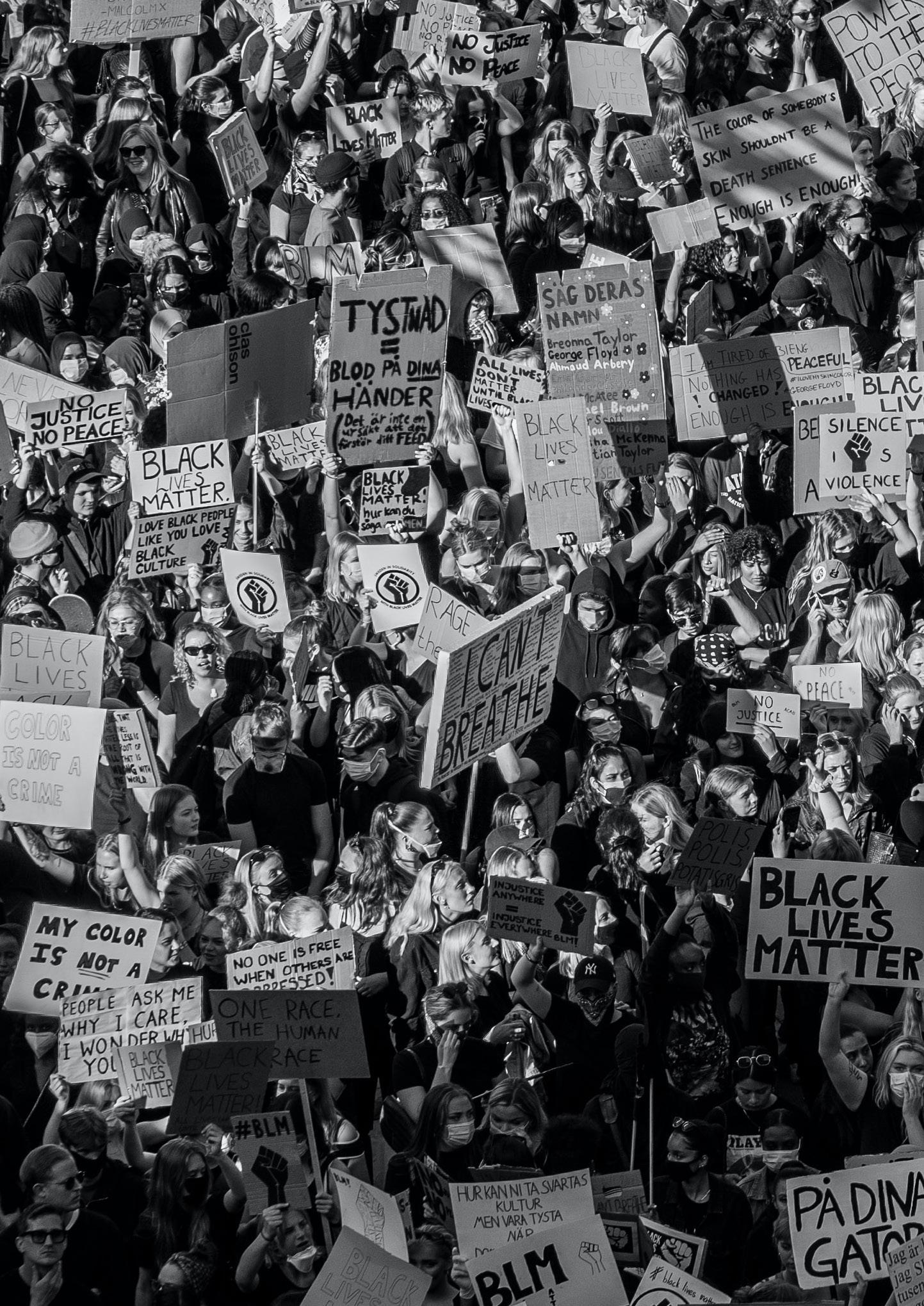
32














 Oscar Terriquez- Hernandez
Oscar Terriquez- Hernandez









